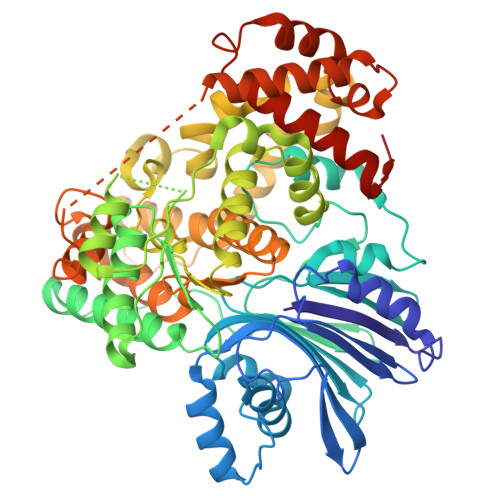Substrate Recognition Mechanism of a Trichostatin A-Forming Hydroxyamidotransferase.
Nagata, R., Nishiyama, M., Kuzuyama, T.(2023) Biochemistry 62: 1833-1837
- PubMed: 37167424
- DOI: https://doi.org/10.1021/acs.biochem.3c00025
- Primary Citation of Related Structures:
7YLZ - PubMed Abstract:
The hydroxyamidotransferase TsnB9 catalyzes hydroxylamine transfer from l-glutamic acid γ-monohydroxamate to the carboxyl group of trichostatic acid to produce the terminal hydroxamic acid group of trichostatin A, which is a potent inhibitor of histone deacetylase (HDAC). The reaction catalyzed by TsnB9 is similar to that catalyzed by glutamine-dependent asparagine synthetase, but the trichostatic acid recognition mechanism remains unclear. Here, we determine the crystal structure of TsnB9 composed of the N-terminal glutaminase domain and the C-terminal synthetase domain. Two consecutive phenylalanine residues, which are not found in glutamine-dependent asparagine synthetase, in the N-terminal glutaminase domain structurally form the bottom of the hydrophobic pocket in the C-terminal synthetase domain. Mutational and computational analyses of TsnB9 suggest five aromatic residues, including the two consecutive phenylalanine residues, in the hydrophobic pocket are important for the recognition of the dimethylaniline moiety of trichostatic acid. These insights lead us to the discovery of hydroxyamidotransferase to produce terminal hydroxamic acid group-containing HDAC inhibitors different from trichostatin A.
- Graduate School of Agricultural and Life Sciences, The University of Tokyo, 1-1-1 Yayoi, Bunkyo-ku, Tokyo 113-8657, Japan.
Organizational Affiliation:

















